China Youth & Education
Discussions on Weibo over 10-Year-Old Girl Attending School Event with Fever and IV Drip
Is this father doing the best or the worst for his daughter? Views are divided on Weibo.
Published
6 years agoon
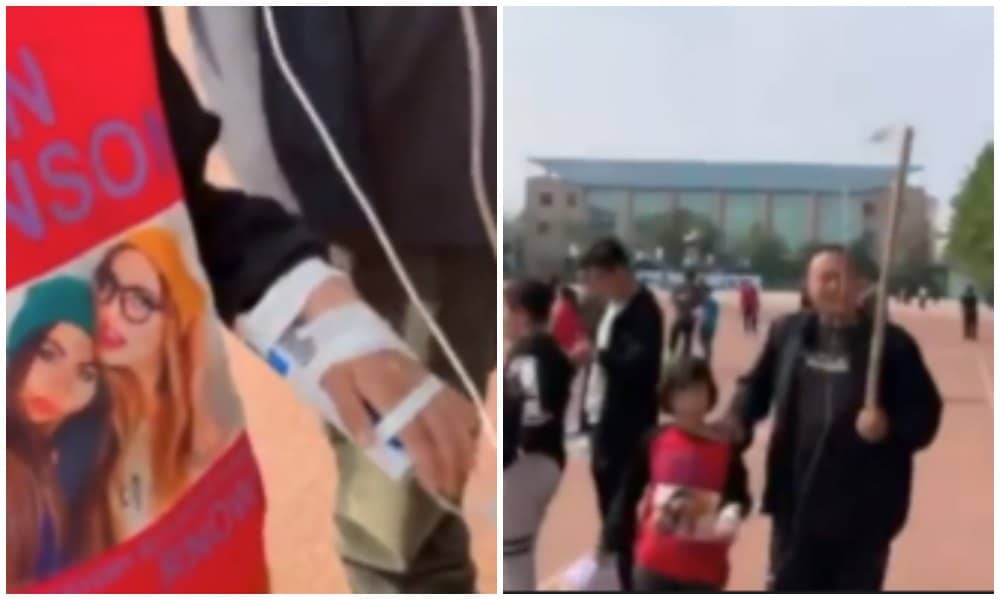
On May 4th, Chinese reporters captured how a sick 10-year-old girl attended a Hengshui High School Open Day event while hooked to an IV. The video report went viral on Chinese social media, triggering discussions on the parental pressure faced by children to succeed in school.
A 10-year-old girl from Hengshui, Hebei, has attracted the attention on Chinese social media after reporters interviewed her while visiting an Open Day of a local school. The girl was ill and hooked up to an intravenous drip.
On May 4th, the Hengshui High School had its annual Open Day and information event when reporters captured the girl walking together with her father, who was holding her IV drip.
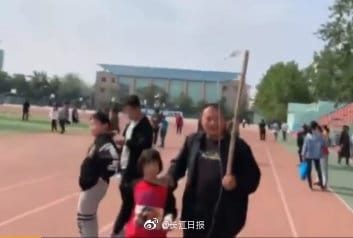
The father told Pear Video that his daughter had a fever of 38 to 39 degrees for four consecutive days, for which she had an IV, but that they still wanted to visit the Open Day to “take in the atmosphere,” saying it is the girl’s “dream” to get admitted to the school.
The man further said that he himself is “uncultured,” but that he hopes his daughter would be an educated person, and that she will “definitely pass” the school’s entrance exams.
With over 14 million views, the hashtag “Girl with IV Drip Visits Hengshui Middle School” (#女童边输液边参观衡水中学#) became one of the top trending topics of the day on Weibo.
Many commenters condemn the father for pressuring his daughter to succeed in school and for not prioritizing her health. “At the age of ten, there’s still some years before middle school – it’s not something to be concerned over at this point,” some say, with others calling the father’s attitude “scary” and “horrible.”
There are those netizens who blame the father for letting his child make up for his own “uncultured” status.
Hengshui High School is a prestigious high school in Hebei Province that was established in 1951, and that is known for its strict regulations and harsh study schemes.
Academic Stress Starts Early
China’s educational system has nine years of compulsory education, starting at the age of six. After elementary school and junior high, the majority of children continue studying at a vocational school or (senior) high school, for which they will have to take an entrance exam during their last year in junior high.
The gaokao (literally: ‘higher exams’) are generally regarded the most important moment in a student’s life. They are a prerequisite for entering China’s higher education institutions and are usually taken by students in their last year of senior high school. Scoring high grades for this exam can give high school students access to a better college, which enlarges their chances of obtaining a good job after graduation, and are therefore seen as life-changing.
All the schools leading up to the gaokao, from elementary to high school, could potentially give children an academic advantage. Attending the best schools from an early age is a strategic move on the road to educational success. This also means that children as young as ten could already face much pressure to succeed.
In 2017, the suicide of a 10-year-old girl from Jiangsu province made headlines in China. The young girl stated in her farewell message that she wanted to go to heaven because she was “not doing well in school.”
In November of 2014, the suicide of a 10-year-old boy from Guangzhou after his mid-term exams also shocked netizens. The boy, who received just 39 points for an English exam, hung himself after writing about his low grade in his diary. A year prior, in 2013, another 10-year-old committed suicide by jumping from a building after being scolded by a teacher after failing to complete an assignment.
Rising out of Poverty through Education?
Despite all the commenters on Weibo who condemn the 10-year-old’s father for taking his sick daughter to an Open Day, there also many who jump to his defense.
“What other way to change your poor lower class status than by studying hard?” one person writes: “Our college entrance examination system is really fair (..) As a poor child, you can continue to work hard, and one day, you will stand out from the crowd for it.”
“Every time I see news like this it makes me feel bad, but I can also understand,” others say.
It is not known if the girl and her parents indeed come from a poor family, nor have their names been disclosed.
“I sympathize with this dad,” another Weibo user writes: “He doesn’t know what it is to study, but he’d do anything to make his kid [study]. I went through the same thing as a kid. Due to chronic tonsillitis, I’d run a fever three times a month (..) but you can’t make your illness stop you from studying. I can only say that our generation will rise and make sure the next generation will grow up happier.”
Many commenters contradict those who condemn the father, saying he is just doing what he thinks is best for his child: “It is clear that he really loves her.”
But the polarized views on this issue still stand, with some writing: “What scares me the most is all these people who think the father is right.”
By Manya Koetse
Spotted a mistake or want to add something? Please let us know in comments below or email us.
©2019 Whatsonweibo. All rights reserved. Do not reproduce our content without permission – you can contact us at info@whatsonweibo.com
Manya is the founder and editor-in-chief of What's on Weibo, offering independent analysis of social trends, online media, and digital culture in China for over a decade. Subscribe to gain access to content, including the Weibo Watch newsletter, which provides deeper insights into the China trends that matter. More about Manya at manyakoetse.com or follow on X.
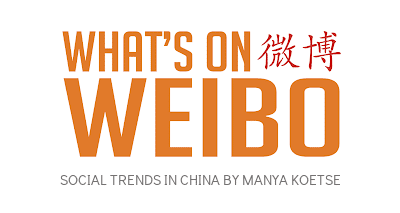
China Memes & Viral
The ‘Cycling to Kaifeng’ Trend: How It Started, How It’s Going
The Kaifeng cycling craze revealed more than just the adventurous spirit of Chinese students.
Published
3 weeks agoon
November 12, 2024
PREMIUM CONTENT
From city marketing to the spirit of China’s new generation, there are many themes behind the recent Zhengzhou trend of thousands of students cycling to Kaifeng overnight.
The term ‘yè qí‘ (夜骑), meaning “night ride,” has recently become a buzzword on Chinese social media. Large groups of students from various schools and universities in Zhengzhou, the capital of Henan province with a population of over 12 million, have been cycling en masse on shared bikes to Kaifeng, a neighboring historic city of around 5 million residents. These journeys often begin in the evenings or around midnight.
Across multiple platforms, videos of swarms of cyclists heading to Kaifeng have gone viral. The footage is striking, capturing streams of students embarking on the 40-mile nighttime journey, some waving Chinese flags, filming on their phones, singing together, and clearly having a great time.
According to some reports, approximately 100,000 or even 200,000 students have participated in these rides, drawing significant media attention both in China and internationally—especially after authorities began imposing restrictions on the so-called ‘Night Riding Army.’
HOW IT STARTED
The true origins of this story seem a bit murky.
The first Chinese news reports and blogs about students cycling to Kaifeng began surfacing around November 2-3 this year, coinciding with the first large-scale group rides from Zhengzhou to Kaifeng. The trend seemed to emerge out of nowhere.
On November 3, numerous Chinese media outlets provided an explanation for the phenomenon. According to these reports, on June 18, 2024, four female friends allegedly decided, at 7 PM, to embark on a 40-mile journey from Zhengzhou to Kaifeng to try out the city’s renowned soup dumplings. It took them around five hours to ride there, and, when they shared their adventure online, they used the slogan: “Youth only comes once” (青春只有一次).

These four girls allegedly started the Kaifeng night ride trend in June of 2024 (The Paper).
Their posts were said to have inspired hundreds of other students to follow suit, organizing night rides in groups with the trend peaking during the first two weekends of November. This narrative of an organic trend of night riding to Kaifeng for dumplings was picked up by Western media outlets, including reports from the BBC and The Guardian.
Earlier in summer, some Henan media indeed reported about four girls doing a night ride to Kaifeng. This was followed by another video by a Douyin user (@去你的岛), dated June 23, documenting a ride from Zhengzhou to Kaifeng for breakfast. That video was later turned into a small news item (dated June 29, but showing footage of the June 23 ride). Aside from an October 6 video by another Douyin user (@小木同学) imitating the June 23 group by cycling to Kaifeng with friends, however, there is a notable lack of videos indicating a widespread cycling-to-Kaifeng trend before the large-scale group rides of November 2-3. Moreover, the original posts by the four girls are nowhere to be found.
This raises questions: How did the story of the four girls gain traction without leaving a significant digital footprint? Was the Zhengzhou-to-Kaifeng cycling trend a truly organic movement, or could it have been more orchestrated? Curiously, the Weibo hashtag “How did the college students’ night ride to Kaifeng initially start?” (#大学生夜骑开封最早是怎么开始的#), which had been used by multiple bloggers, was also taken offline at the time of writing.

Screenshot of Weibo hashtag not being displayed.
The origins of the trend are particularly relevant as Chinese cities fiercely compete to become the next social media sensation. Since Zibo’s viral success, third- and second-tier cities across China have been striving to replicate its fame. While it’s ideal to become the next travel hit organically, cities often benefit from promoting local specialities and hyping up meme-worthy moments. Cities like Tianshui in Gansu and Harbin have enjoyed their moments in 2024, propelled by memes and viral content.
Kaifeng had already launched initiatives to boost tourism before the cycling trend. In March, a special shuttle service from Zhengzhou to Kaifeng was introduced to encourage day trips. In April, the city debuted its “Wang Po Matchmaking” show at Wansui Mountain Martial Arts City to attract tourists.
Tourist offices nationwide have become increasingly savvy in using social media for city marketing. Given the absence of a substantial social media trend from June to November, it seems plausible that the cycling phenomenon was a coordinated marketing effort. It likely began with a large group ride in early November, which sparked student interest, and snowballed. Kaifeng capitalized on the social media buzz starting November 2, but the scale of the phenomenon probably far exceeded what anyone had expected.
A CRAZY RIDE
As the ‘Zhengzhou to Kaifeng Night Ride’ was reported by local media and hit social media charts during the first weekend of November, it didn’t take long for students to catch on and join the ride. By the second weekend of November, Zhengkai Avenue, the main road from Zhengzhou to Kaifeng, was buzzing with activity, packed with thousands of university students participating in the night ride. Waving national flags, singing songs – including the national anthem -, taking group pictures, the moment was all that mattered.

Night riding while waving the national flag.
While some foreign media speculated that the movement carried political undertones, citing at least one flag on the road advocating for the reunification of Taiwan with the motherland, it was likely more about patriotic youth waving non-controversial flags while channeling some nationalistic energy.
It was about “passion”—an English word that became synonymous with the nightly bike ride. It wasn’t about the soup dumplings or the exercise; it was about joy, freedom, and the pure, youthful energy of passion—an important theme for China’s Generation Z, the post-95 and post-00 generations, who often feel pushed and sometimes even paralyzed by the intense social pressures they face.
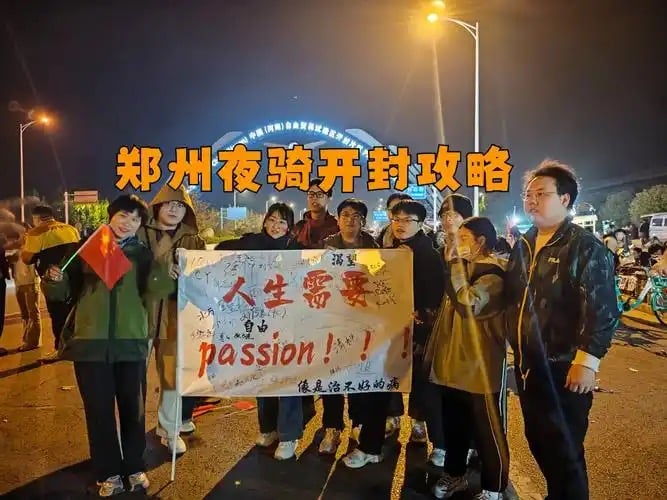
Night riders posing with a poster saying : You need passion in your life (source).
The trend was supported (or facilitated?) by Kaifeng authorities. On November 3, they set up shared bike stations along Zhengkai Avenue to manage the influx of cyclists. Police provided guidance at the scene and ensured safety throughout the night. Kaifeng’s Tourism Bureau issued a “cycling safety advisory” via its official WeChat account, encouraging visitors to adhere to traffic rules, travel sustainably, avoid peak times, and “enjoy the seasonal beauty of Kaifeng with a positive attitude.”
Starting on November 3, Kaifeng’s main tourist attractions, such as Millennium City Park, Wansui Mountain, and Daxiangguo Temple were specially opened to the ‘night riders’ in the middle of the night, even offering them free annual tourism passes (#开封多个景点为夜骑大学生免费#). At this time, the slogan “Youth is priceless, seize the night ride to Kaifeng” (“青春没有售价,夜骑开封拿下”) was actively promoted at Kaifeng tourist spots and in the media.
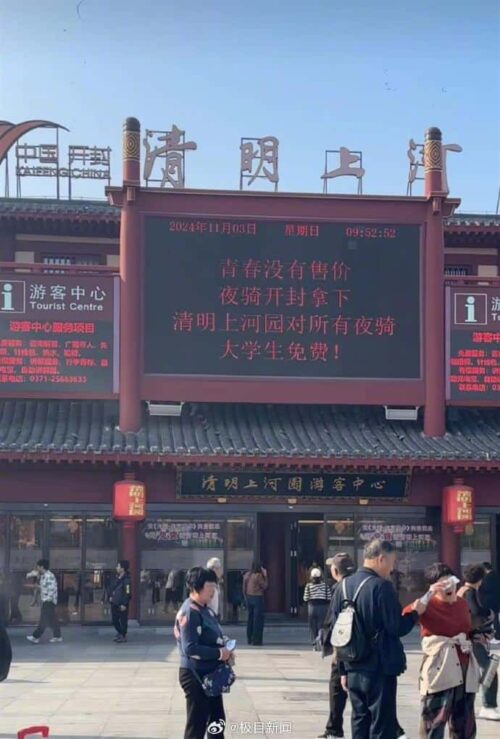
Historical cultural theme park Millennium City Park in Kaifeng on November 3, promoting free access to night riders and the slogan “Youth is priceless, seize the night ride to Kaifeng.”
The shuttle bus taking students back to Zhengzhou was provided for free.
On social apps like Xiaohongshu, students shared various ‘strategy guides’ for the best way to navigate the nightly ride to Kaifeng, including tips such as:
- Choose a comfortable shared bike and avoid unlocking it along the way. With a bike like HelloBike, the journey will only cost 19.5 RMB ($2.70). Starting from Zhengzhou Sports Center Station, head north on Jinshui Road and cycle east in a straight line to Kaifeng. The trip should take about 4 hours.
- From Zhengzhou University to Kaifeng Gulou, the total distance is 79.4 km, with an estimated travel time of 6 hours and 38 minutes. Including breaks and meal stops, the journey could take at least 8 hours.
- Bring a small flag for photo opportunities.
- Upon arrival, visit the Haidilao hotpot restaurant, where they provide blankets and snacks.
- Must-try local dishes: soup dumplings, egg casserole, and deep-fried dough with soy milk.
GOING DOWNHILL
During the weekend of November 8-9, numerous videos emerged showing thousands of students cycling from Zhengzhou to Kaifeng, revealing chaotic scenes (link, link). Some estimates suggested that over 30,000 students had arrived in Kaifeng in a single night.
The trend had a significant impact, raising several concerns. Safety issues loomed large as the sheer number of bicycles on the road created risks, especially given that many participants lacked experience with long-distance cycling. Traffic congestion reached such levels that some cars became trapped amid the cycling groups.

The shared bike system also faced severe challenges. While students eagerly undertook the 4-5 hour downhill journey to Kaifeng, they were unwilling to make the uphill return to Zhengzhou. This resulted in thousands of bikes being abandoned in Kaifeng or along the route, requiring retrieval by the bike companies.
Beyond logistical strain on the bike-sharing system, the abandoned bikes caused significant disruptions in Kaifeng, with entire roads blocked. In Zhengzhou, locals complained about a lack of available bikes for their commutes.

Shared bike chaos in Kaifeng.
While some praised the students’ adventurous spirit, others grew increasingly frustrated with the mounting problems.
By the afternoon of November 9, the official narrative shifted.
Initially, Chinese media celebrated the trend, but reports soon focused on its downsides. One widely shared story featured a 34-year-old man who had joined the ride with his daughter. Unaccustomed to cycling, he became exhausted after only 12-13 kilometers (about 8 miles) (#郑州34岁男子跟风夜骑开封后住院#). He was later hospitalized and diagnosed with hypokalemia (low potassium levels). The message? “Don’t blindly follow the trend.”
Authorities quickly stepped in to stop the night rides. Traffic police in Zhengzhou and Kaifeng issued a joint announcement banning the use of bike lanes on Zhengkai Avenue from 16:00 on November 9 to 12:00 on November 10.
Three major shared bike companies—Meituan, HelloBike, and Qingju—released statements reminding users that their bikes were not intended for cross-city travel. Bikes taken beyond designated zones would automatically lock and incur ‘relocation fees.’
Several universities implemented strict measures, ordering students back to campus and enforcing lockdowns. By Sunday night, some students took to Weibo to report that they were still not allowed to leave their campuses.
THE ROAD AHEAD
Despite the official crackdown on night rides to Kaifeng, some Zhengzhou students have now shifted to walking the entire route, a journey that can take up to 11 hours—equating to 70,000-100,000 steps on a smartwatch pedometer.

Unable to cycle, groups of students decided to walk to Kaifeng.
The crackdown on the nightly cycling craze has also prompted some reflection.
While many netizens praise the students for “truly embodying youth and vitality,” others see a deeper significance in the trend.
On Weibo, author Xu Kaizhen (许开祯) offers his perspective on what the Kaifeng phenomenon reveals about Chinese youth today. He writes:
“On the surface, the Kaifeng craze appears to be the latest trend in cultural tourism. But at its core, it has nothing to do with tourism. What is it really about? It’s about young people, about youth. And it’s not about youthful rebellion or hormones—modern youth have moved beyond that. It’s about escape. A collective, grand escape. An escape from a mediocre era, a mediocre life, and even a mediocre background. Every young person who joined the night ride was driven by a need to escape. Dissatisfied with reality yet powerless to change it, they turned to this collective unconscious act of performance art.”
Despite the criticism, it seems many hold a soft spot for China’s youth, understanding the challenges they face. As one popular comment puts it: “I dearly love this generation of Chinese youth. Their daytime has been drained by the previous generation, leaving only the night for them to carve out some space to unwind. ‘Escape’ describes it perfectly.”
For now, it seems the Kaifeng trend isn’t over. What began as an innocent, fun-loving initiative has turned into a mass mobilization that raises questions about hyped-up tourism, city marketing, and, most importantly, the boundless energy of China’s new generation. While the phenomenon has left many puzzled, some argue it’s crucial to grasp the youth’s yearning for these kinds of adventures.
As Xu Kaizhen concluded: “Perhaps by understanding this night ride, we can truly understand this generation. No—perhaps we can begin to understand the coming era.”
See our X thread with videos on this trend.
By Manya Koetse, with contributions by Miranda Barnes
(follow on X, LinkedIn, or Instagram)
Spotted a mistake or want to add something? Please let us know in comments below or email us. First-time commenters, please be patient – we will have to manually approve your comment before it appears.
©2024 Whatsonweibo. All rights reserved. Do not reproduce our content without permission – you can contact us at info@whatsonweibo.com.
China Society
Death of Chinese Female Motorcycle Influencer ‘Shigao ProMax’ Sparks Debate on Risky Rides for Online Attention
After the tragic death of young motorcyclist ‘Shigao ProMax,’ netizens criticize influencers for reckless riding in pursuit of followers and likes.
Published
2 months agoon
October 2, 2024
A Chinese female motorcyclist from Suzhou, known as “Shigao ProMax” (@石膏ProMax) on Douyin, tragically passed away this week following a motorcycle crash in Suzhou’s Wujiang District.
The incident occurred in the late afternoon of September 29, when the 19-year-old Shigao, whose real name was Yang Huizi (杨惠子), was a passenger on the motorcycle, with her (male) friend driving the vehicle.
As the motorcycle collided with a car emerging from a side intersection, Yang was thrown off the back, propelled several meters through the air before landing on the road. Although she was reportedly wearing a helmet, it cracked during the crash, and she sustained a severe head injury.
A video circulating on social media shows the aftermath of the accident, with the motorcycle driver lying on the road and Yang Huizi a few meters away, initially attempting to crawl before collapsing (warning for graphic content). Despite rescue efforts, she later died in the hospital. The current condition of Yang’s friend, the rider, remains unclear.

Screenshot of the scene of the accident.
Yang had nearly 80,000 fans on Douyin, where she posted her first video in December 2019. By September 2024, she had shared a total of 1,298 videos.
On Weibo, many commenters voiced concern over how the news was headlined, criticizing the emphasis on her gender in the hashtag. The hashtag “Famous Female Rider Shi Gao Dies in Traffic Accident” (#网红女骑士石膏发生车祸身亡#) garnered over 170 million views on Weibo on Tuesday. Many commenters felt the headline made it seem as if the young woman had crashed the motor herself, while she was merely a passenger.
Others, however, see this trending news as an opportunity to highlight the risky behavior of motorcyclists, who not only endanger their own lives by speeding but also jeopardize the safety of others by showing off in traffic and driving recklessly.
Especially female influencers/motorcyclists are criticized for careless driving while flaunting their looks for social media posts.
Over the past years, the death of multiple motorcycle influencers have made Chinese headlines. In 2022, a popular Douyin influencer and motorcyclist known as “Xiaoyu Loves Eating Fish” (@小鱼爱吃鱼) died in a collision after riding in the wrong lane. She was instantly killed on the spot. Xiaoyu had gained attention for her risky driving behavior, often wearing short skirts, tight leggings, or other revealing outfits instead of proper motorcycle gear.

“Xiaoyu Loves Eating Fish,” images via Tencent News
In 2023, two young girls—one 16 and the other 21—tragically lost their lives after their motorcycle crashed into a pillar. They were speeding and, apart from wearing helmets, were dressed in skirts and stockings with no additional protective gear. Both died instantly. The 16-year-old, known as An’an (安安), was a social media influencer. Her followers had previously warned her about her reckless behavior. She rode a motorcycle without a license.

An’an’s social media profile.
Within one year alone, from October 2022 to September 2023, at least seven motorcycle influencers made headlines in China after losing their lives in traffic accidents. Some bloggers blame the intense competition for online attention for these accidents, as influencers pull dangerous stunts and push the boundaries to gain more likes and followers.
Posting a video of a woman posing for a video while riding a motorcycle, the popular Weibo content creator HuangXiPao (@黄西炮) wrote: “So many female motorcycle influencers have died, yet it doesn’t stop others from still posing on the road for photos! Is this trend really that profitable?”
One commenter expresses frustration over how news about motorcycle influencers consistently reaches the top trending lists, while other serious incidents, such as the big stabbing incident that happened in Shanghai this week, seem to be kept off the hot lists. “Every time a female motorcycle influencer dies, it makes the trending lists. Meanwhile, three people are dead and 18 injured in Shanghai! Yet you’ve completely suppressed the search term (…) What is this about?!”
News about the motorcycle incident is also a reason for official channels to remind netizens about road safety. The official China Police account shared photos of the incident, stating: “Raise safety awareness and take responsibility for your life.”

By Manya Koetse
(follow on X, LinkedIn, or Instagram)
Spotted a mistake or want to add something? Please let us know in comments below or email us. First-time commenters, please be patient – we will have to manually approve your comment before it appears.
©2024 Whatsonweibo. All rights reserved. Do not reproduce our content without permission – you can contact us at info@whatsonweibo.com.
Subscribe

The ‘Cycling to Kaifeng’ Trend: How It Started, How It’s Going

Hu Xijin’s Comeback to Weibo

Weibo Watch: “Comrade Trump Returns to the Palace”

The Price of Writing Smut: Inside China’s Crackdown on Erotic Fiction

Controversial Wanghong Livestreamers Are Becoming a Weibo Staple in China

“Land Rover Woman” Sparks Outrage: Qingdao Road Rage Incident Goes Viral in China

Death of Chinese Female Motorcycle Influencer ‘Shigao ProMax’ Sparks Debate on Risky Rides for Online Attention

Weibo Watch: The Land Rover Woman Controversy Explained

Fired After Pregnancy Announcement: Court Case Involving Pregnant Employee Sparks Online Debate

Weibo Watch: Going the Wrong Way

Hidden Hotel Cameras in Shijiazhuang: Controversy and Growing Distrust

China at the 2024 Paralympics: Golds, Champions, and Trending Moments

Weibo Watch: Small Earthquakes in Wuhan

Why the “人人人人景点人人人人” Hashtag is Trending Again on Chinese Social Media

The Hashtagification of Chinese Propaganda
Get in touch
Would you like to become a contributor, or do you have any tips or suggestions? Get in touch here!
Popular Reads
-
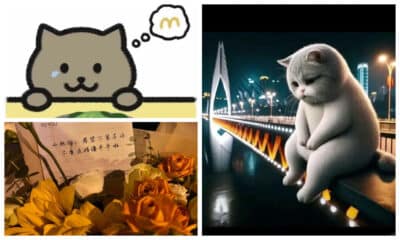
 China Insight7 months ago
China Insight7 months agoThe Tragic Story of “Fat Cat”: How a Chinese Gamer’s Suicide Went Viral
-

 China Music8 months ago
China Music8 months agoThe Chinese Viral TikTok Song Explained (No, It’s Not About Samsung)
-

 China Insight9 months ago
China Insight9 months agoThe ‘Two Sessions’ Suggestions: Six Proposals Raising Online Discussions
-

 China Arts & Entertainment11 months ago
China Arts & Entertainment11 months agoJia Ling Returns to the Limelight with New “YOLO” Movie and 110-Pound Weight Loss Announcement




